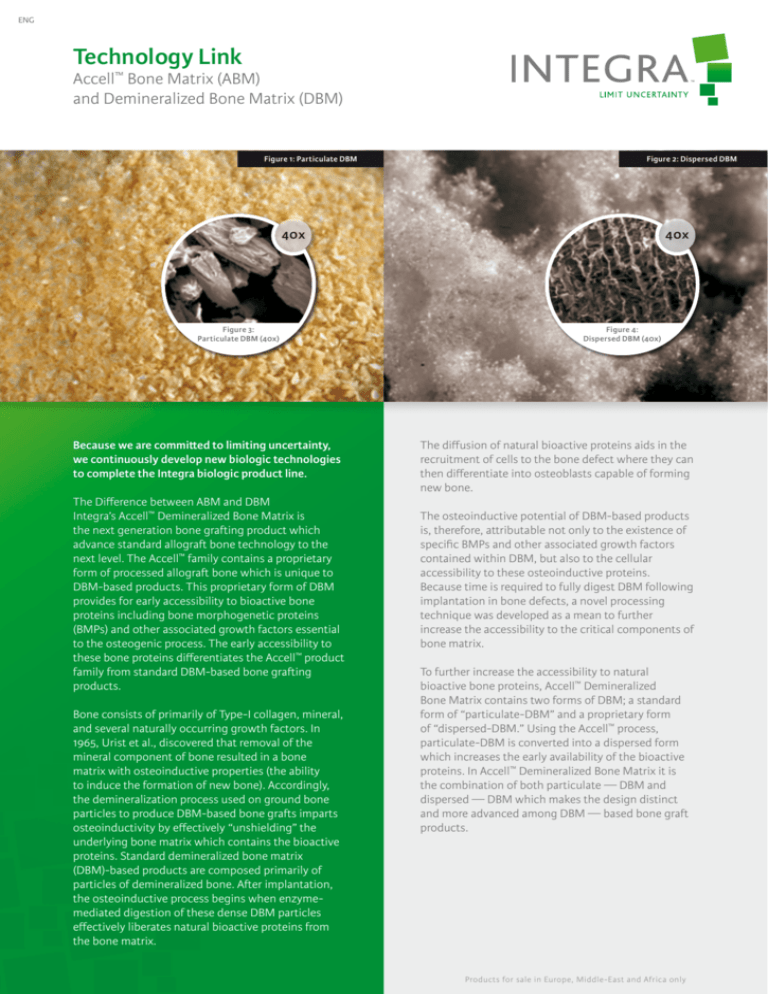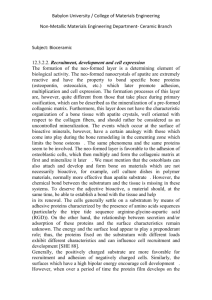
ENG
Technology Link
Accell™ Bone Matrix (ABM)
and Demineralized Bone Matrix (DBM)
Figure 1: Particulate DBM
Figure 2: Dispersed DBM
40x
Figure 3:
Particulate DBM (40x)
Because we are committed to limiting uncertainty,
we continuously develop new biologic technologies
to complete the Integra biologic product line.
The Difference between ABM and DBM
Integra’s Accell™ Demineralized Bone Matrix is
the next generation bone grafting product which
advance standard allograft bone technology to the
next level. The Accell™ family contains a proprietary
form of processed allograft bone which is unique to
DBM-based products. This proprietary form of DBM
provides for early accessibility to bioactive bone
proteins including bone morphogenetic proteins
(BMPs) and other associated growth factors essential
to the osteogenic process. The early accessibility to
these bone proteins differentiates the Accell™ product
family from standard DBM-based bone grafting
products.
Bone consists of primarily of Type-I collagen, mineral,
and several naturally occurring growth factors. In
1965, Urist et al., discovered that removal of the
mineral component of bone resulted in a bone
matrix with osteoinductive properties (the ability
to induce the formation of new bone). Accordingly,
the demineralization process used on ground bone
particles to produce DBM-based bone grafts imparts
osteoinductivity by effectively “unshielding” the
underlying bone matrix which contains the bioactive
proteins. Standard demineralized bone matrix
(DBM)-based products are composed primarily of
particles of demineralized bone. After implantation,
the osteoinductive process begins when enzymemediated digestion of these dense DBM particles
effectively liberates natural bioactive proteins from
the bone matrix.
40x
Figure 4:
Dispersed DBM (40x)
The diffusion of natural bioactive proteins aids in the
recruitment of cells to the bone defect where they can
then differentiate into osteoblasts capable of forming
new bone.
The osteoinductive potential of DBM-based products
is, therefore, attributable not only to the existence of
specific BMPs and other associated growth factors
contained within DBM, but also to the cellular
accessibility to these osteoinductive proteins.
Because time is required to fully digest DBM following
implantation in bone defects, a novel processing
technique was developed as a mean to further
increase the accessibility to the critical components of
bone matrix.
To further increase the accessibility to natural
bioactive bone proteins, Accell™ Demineralized
Bone Matrix contains two forms of DBM; a standard
form of “particulate-DBM” and a proprietary form
of “dispersed-DBM.” Using the Accell™ process,
particulate-DBM is converted into a dispersed form
which increases the early availability of the bioactive
proteins. In Accell™ Demineralized Bone Matrix it is
the combination of both particulate — DBM and
dispersed — DBM which makes the design distinct
and more advanced among DBM — based bone graft
products.
Products for sale in Europe, Middle-East and Africa only
Technology Link
Accell™ Bone Matrix (ABM)
and Demineralized Bone Matrix (DBM)
The combination of a highly dispersed form of DBM and
particulate-DBM provides the unique advantage to Accell™
Demineralized Bone Matrix over traditional DBM-based bone
products limited to utilizing only particulate forms of DBM in
the formulation.
In a study presented at the 52nd Annual Meeting of the
Orthopaedic Research Society, it was shown that dispersedDBM produced from the Accell™ process contains a natural
array of growth factors, including BMP-2, 4, 7, and TGF-ß1.
Apart from the presence of these growth factors, it is the
structural differences between dispersed and particulate-DBM
that make the Accell™ technology unique (see Figures 1– 5).
Figure 5: Dispersed DBM
In a more recent study presented at the 55th Annual Meeting
of the Orthopaedic Research Society, it was shown that in
the presence of collagenase (an enzyme used to mimic in
vivo degradation of DBM), it takes approximately 5 days for
particulate-DBM to reach maximal accessibility to the bioactive
bone proteins. In contrast, dispersed-DBM (with or without
collagenase) was shown to reach maximal accessibility to the
bioactive bone proteins within 4 hours of hydration.
Figure 7: Combination of Dispersed
and Particulate DBM (40x)
As shown in Figure 8, the accessibility to BMP-2 occurs rapidly
in dispersed-DBM whereas the accessibility to BMP-2 in
particulate-DBM is slower and sustained over a longer period
of time. These results are anticipated considering the inherent
dense nature of DBM particles in contrast to the highly porous
nature of the dispersed form (see Figures 3 and 4).
Figure 6: Particulate DBM
The differences in the structural organization of Type-I
collagen and natural bioactive bone proteins in particulate and
dispersed forms of DBM is graphically represented in Figures 6
and 7. The in-vivo component of this study demonstrated that
Accell™ technology was as effective as iliac crest bone graft in
generating new bone in a challenging spine fusion model.
Accell™ w/o collagenase
18.00
DBM w/ collagenase
16.00
DBM w/o collagenase
BMP-2 Conteny (ng/g)
14.00
References
1. M. R. Urist
Formation by Autoinduction. Science 150: 893-899, 1965
12.00
10.00
8.00
6.00
2. R.Fuhrmann, A. Wagner, J. Anders
Tissue repair composition and methods for their
manufacture and use. US Patent No. 7,132,110.
4.00
2.00
0.00
3. Evaluation of Next Generation DBM Putty in a Posterolateral
Spinal Fusion Model. Paper # 1834, 55th Annual Meeting
of the Orthopaedic Research Society (2009).
Integra LifeSciences Services (France) SAS
Sales & Marketing EMEA
Immeuble Séquoia 2 97 allée Alexandre Borodine
Parc technologique de la Porte des Alpes
69800 Saint Priest FRANCE
Phone +33 (0)4 37 47 59 00 Fax +33 (0)4 37 47 59 99
emea.info@integralife.com integralife.eu
www.integraorthobiologics.com
0
20
40
60
80
100
120
Time (hrs)
Figure 8: Accessibility to a Specific Bioactive Bone Protein,
Dispersed vs. Particulate DBM
Distributed by
IsoTis Orthobiologics
2 Good Year Suite A Irvine, CA 92618 United States of America
+1 (949) 595 8710 fax: +1 949 595 8711 97
©2011 Integra LifeSciences Corporation. All rights reserved. ILS 07-06-001-01-11
PRODUCTS FOR SALE IN EUROPE, MIDDLE-EAST and AFRICA ONLY
Availability of these products might vary from a given country or region to another, as a result of specific local regulatory approval or clearance
requirements for sale in such country or region. Always refer to the appropriate instructions for use for complete clinical instructions. Non
contractual document. The manufacturer reserves the right, without prior notice, to modify the products in order to improve their quality.
WARNING: Applicable laws restrict these products to sale by or on the order of a physician. Accell, Integra and the Integra logo are trademarks
of Integra LifeSciences Corporation or its subsidiaries. All the references numbers mentioned on this document are CE marked according to
European council directive 93/42/EEC on medical devices, unless specifically identified as “NOT CE MARKED.”








